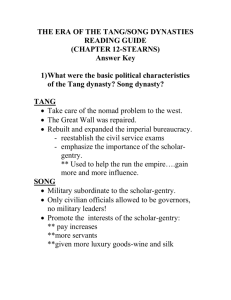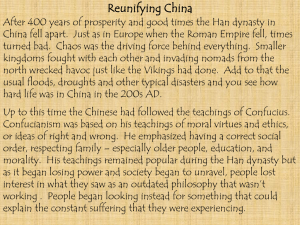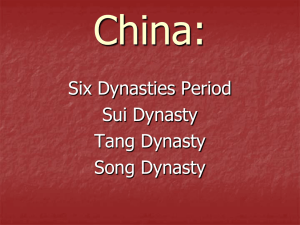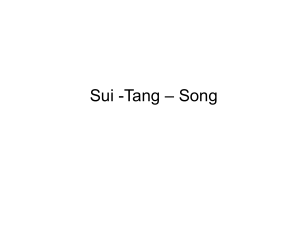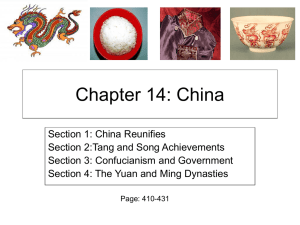Key Points Chapter 12
advertisement
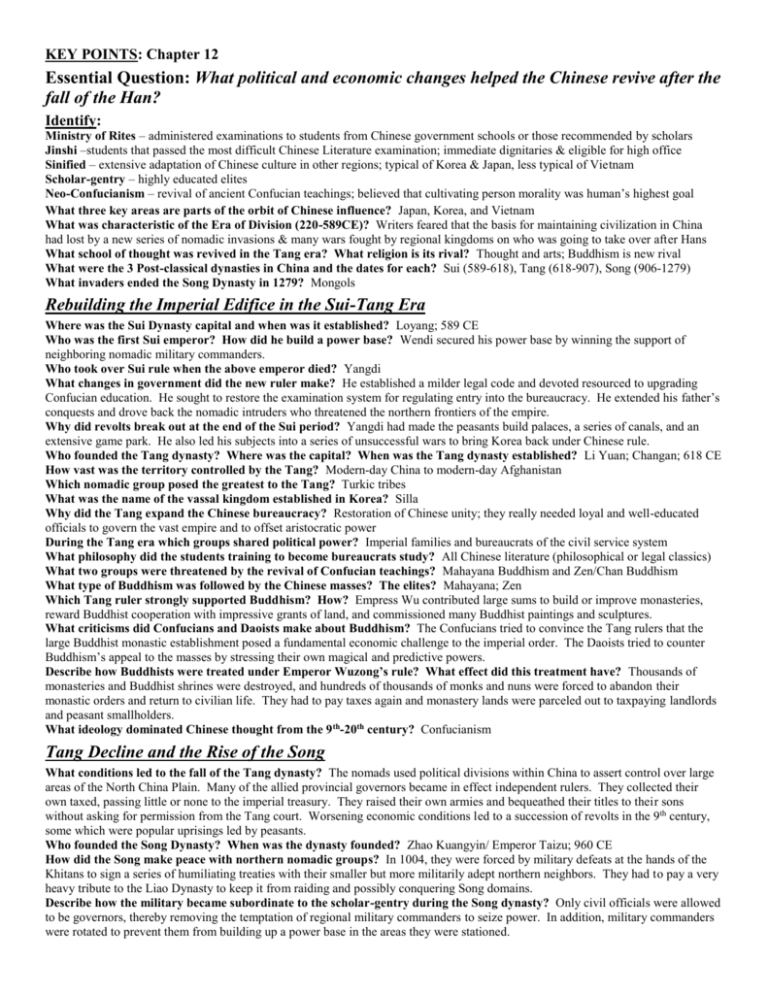
KEY POINTS: Chapter 12 Essential Question: What political and economic changes helped the Chinese revive after the fall of the Han? Identify: Ministry of Rites – administered examinations to students from Chinese government schools or those recommended by scholars Jinshi –students that passed the most difficult Chinese Literature examination; immediate dignitaries & eligible for high office Sinified – extensive adaptation of Chinese culture in other regions; typical of Korea & Japan, less typical of Vietnam Scholar-gentry – highly educated elites Neo-Confucianism – revival of ancient Confucian teachings; believed that cultivating person morality was human’s highest goal What three key areas are parts of the orbit of Chinese influence? Japan, Korea, and Vietnam What was characteristic of the Era of Division (220-589CE)? Writers feared that the basis for maintaining civilization in China had lost by a new series of nomadic invasions & many wars fought by regional kingdoms on who was going to take over after Hans What school of thought was revived in the Tang era? What religion is its rival? Thought and arts; Buddhism is new rival What were the 3 Post-classical dynasties in China and the dates for each? Sui (589-618), Tang (618-907), Song (906-1279) What invaders ended the Song Dynasty in 1279? Mongols Rebuilding the Imperial Edifice in the Sui-Tang Era Where was the Sui Dynasty capital and when was it established? Loyang; 589 CE Who was the first Sui emperor? How did he build a power base? Wendi secured his power base by winning the support of neighboring nomadic military commanders. Who took over Sui rule when the above emperor died? Yangdi What changes in government did the new ruler make? He established a milder legal code and devoted resourced to upgrading Confucian education. He sought to restore the examination system for regulating entry into the bureaucracy. He extended his father’s conquests and drove back the nomadic intruders who threatened the northern frontiers of the empire. Why did revolts break out at the end of the Sui period? Yangdi had made the peasants build palaces, a series of canals, and an extensive game park. He also led his subjects into a series of unsuccessful wars to bring Korea back under Chinese rule. Who founded the Tang dynasty? Where was the capital? When was the Tang dynasty established? Li Yuan; Changan; 618 CE How vast was the territory controlled by the Tang? Modern-day China to modern-day Afghanistan Which nomadic group posed the greatest to the Tang? Turkic tribes What was the name of the vassal kingdom established in Korea? Silla Why did the Tang expand the Chinese bureaucracy? Restoration of Chinese unity; they really needed loyal and well-educated officials to govern the vast empire and to offset aristocratic power During the Tang era which groups shared political power? Imperial families and bureaucrats of the civil service system What philosophy did the students training to become bureaucrats study? All Chinese literature (philosophical or legal classics) What two groups were threatened by the revival of Confucian teachings? Mahayana Buddhism and Zen/Chan Buddhism What type of Buddhism was followed by the Chinese masses? The elites? Mahayana; Zen Which Tang ruler strongly supported Buddhism? How? Empress Wu contributed large sums to build or improve monasteries, reward Buddhist cooperation with impressive grants of land, and commissioned many Buddhist paintings and sculptures. What criticisms did Confucians and Daoists make about Buddhism? The Confucians tried to convince the Tang rulers that the large Buddhist monastic establishment posed a fundamental economic challenge to the imperial order. The Daoists tried to counter Buddhism’s appeal to the masses by stressing their own magical and predictive powers. Describe how Buddhists were treated under Emperor Wuzong’s rule? What effect did this treatment have? Thousands of monasteries and Buddhist shrines were destroyed, and hundreds of thousands of monks and nuns were forced to abandon their monastic orders and return to civilian life. They had to pay taxes again and monastery lands were parceled out to taxpaying landlords and peasant smallholders. What ideology dominated Chinese thought from the 9 th-20th century? Confucianism Tang Decline and the Rise of the Song What conditions led to the fall of the Tang dynasty? The nomads used political divisions within China to assert control over large areas of the North China Plain. Many of the allied provincial governors became in effect independent rulers. They collected their own taxed, passing little or none to the imperial treasury. They raised their own armies and bequeathed their titles to their sons without asking for permission from the Tang court. Worsening economic conditions led to a succession of revolts in the 9th century, some which were popular uprisings led by peasants. Who founded the Song Dynasty? When was the dynasty founded? Zhao Kuangyin/ Emperor Taizu; 960 CE How did the Song make peace with northern nomadic groups? In 1004, they were forced by military defeats at the hands of the Khitans to sign a series of humiliating treaties with their smaller but more militarily adept northern neighbors. They had to pay a very heavy tribute to the Liao Dynasty to keep it from raiding and possibly conquering Song domains. Describe how the military became subordinate to the scholar-gentry during the Song dynasty? Only civil officials were allowed to be governors, thereby removing the temptation of regional military commanders to seize power. In addition, military commanders were rotated to prevent them from building up a power base in the areas they were stationed. What ideas were stressed by neo-Confucians? They believed that cultivating personal morality was the highest goal of humans. They argued could be attained through knowledge gained by book learning and personal observation as well as through contact with men of wisdom and high morality. The basically good nature of humans could be cultivated and superior men, fit to govern and teach others, could be developed. Who was the most prominent neo-Confucian? Zhu Xi What effect did neo-Confucianism have on intellectual and social life in China? The neo-Confucian emphasis on rank, obligation, deference, and traditional rituals reinforced class, age, and class distinctions, particularly as they were expressed in occupational roles. Great importance was given to upholding the authority of the patriarch of the Chinese household, who was compared to the male emperor of the Chinese people as a whole. If men and women kept to their place and performed the tasks of their age and social rank, there would be social harmony and prosperity. If problems arose, the best solutions could be found in examples from the past. What problems lead to the decline of the Song dynasty? The tribute that the Song had to pay these peoples for “protection” of their northern borders was a great drain on the resources of the empire and a growing burden for the Chinese peasantry. Equally burdensome was the cost for the army that the Song had to maintain to guard against invasion from the north. Funds needed to upgrade weapons or repair forts were often diverted to the scholarly pursuits and entertainments of the court and gentry. How did Wang Anshi try to stop the collapse of the Song dynasty? He introduced sweeping reforms. He ran the government on the basis of Legalist assumption that an energetic and interventionist state could greatly increase the resources and strength of the dynasty. He introduced cheap loans and government-assisted irrigation projects to encourage agricultural expansion. He taxed the landlord and scholarly classes and used the increased revenue to establish well-trained mercenary forces to replace the armies made up of unwilling and untrained peasants. He even tried to reorganize university education and reorient the examination system. What event brought an end to Anshi’s reforms? His death in 1085 Where was the capital moved to in the Southern Song period? Hangzhou Tang and Song Prosperity What two rivers were connected by the Grand Canal? Yangtze and Hwang He List what commercial advances were made during this period in China. Horses, Persian rugs, and tapestries passed to China while fine silk textiles, porcelain, and paper was exported to the centers of Islamic civilization. Trading ships for ocean, canal, and river transport improved dramatically. The proportion of exchanges involved in the money economy expanded greatly, and deposit shops were found in many parts of the empire. Cities were filled with shops and stalls that sold products from local farms, regional centers of artisan production, and trade centers as far as the Mediterranean. Describe what Changan and Hangzhou were like. Changan was divided into a highly restricted zone dominated by the palace and the audience halls and a section crowded with ministry and secretariat offices. There were elaborate gardens and a hunting park for the emperors’ and favored courtiers’ entertainment. Towns grew rapidly into cities and cities mushroomed as suburbs spread all around the city walls. Hangzhou was located between a large lake and a river in the Yangtze delta, crisscrossed by canals and bridges. Its location allowed its traders and artisans to prosper through sale of goods or manufacture of products. It was famed for its cleanliness, wealth, and the great variety of entertainment offered. How did the state help encourage agrarian expansion? Their officials encouraged peasant groups to migrate to uncultivated areas or those occupied by shifting cultivators/non-Chinese. They also supported military garrisons to protect these new settlements and to complete the task of conquering the non-Chinese. State-regulated irrigation and embankment systems advanced agrarian expansion. What evidence indicates that women had some improved social position during the Tang and early Song dynasties? Women helped both families negotiate prickly issues like matchmaking and the amount of dowry to be paid. Tang women could wield considerable power at the highest levels of Chinese society. The law allowed divorce by mutual consent of husband and wife. Some wealthy women had other lovers with the knowledge of their husbands. They were allowed some independence. What evidence indicates that women suffered from worsening social conditions in the late Song era? The assertion of male dominance was pronounced by neo-Confucians. They said that the woman’s role was homemaker, mother, and bearer of children. They advocated confining women and emphasized the importance of virginity for young brides, fidelity for wives, and chastity for widows. Men were allowed to have premarital sex without scandal, to take concubines if they could afford them, and to remarry. They also excluded women from education that would allow them to have government positions. List what technological advances the Chinese made in this period. Invention of new tools, production techniques, and weapons; banks, paper money, dikes, dams, regulation of flow in irrigation systems, bridges, fireworks, grenades, bombs, flamethrowers, poisonous gases, rocket launchers, abacus, printing techniques Who was the most famous Tang era poet? Li Bo What two areas of artistic achievement were advanced in this period? Poetry and landscape paintings What ultimately led to the fall of the Song? Mongol invasion



